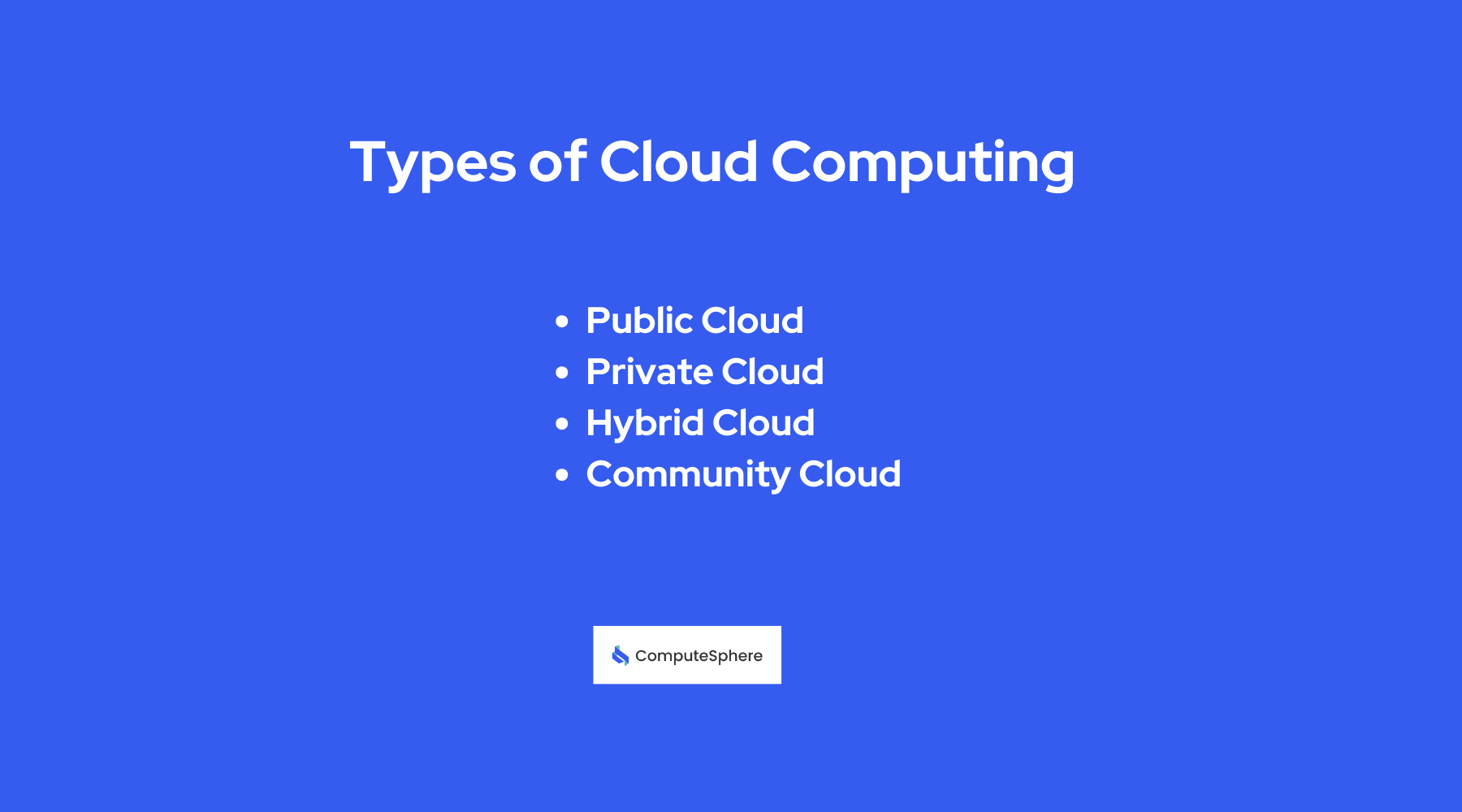Cloud Computing Explained: A Clear and Easy Guide

Cloud computing is transforming data storage, management, and processing through cutting-edge technology. This shift enables organizations of all sizes, from agile startups to large enterprises, to use the cloud's capabilities for driving innovation and improving operational efficiency. Additionally, cloud solutions provide scalable resources and cost-effective infrastructure, enabling businesses to adapt and thrive in a competitive market.
In this comprehensive guide, we will delve into the various types of cloud computing, the benefits it offers, and address the challenges that accompany its adoption.
What is Cloud Computing?
At its core, cloud computing refers to delivering computing services over the Internet. These services include storage, processing power, and software applications. Instead of owning physical servers or data centers, businesses and individuals can access these resources on a pay-as-you-go basis from cloud service providers like Amazon Web Services (AWS), Microsoft Azure, and Google Cloud Platform (GCP).
Basics of Cloud Computing
Cloud computing refers to delivering various services over the Internet, including storage, processing power, and applications. Instead of owning physical hardware, users can access these resources on-demand from a cloud provider.
Key characteristics of cloud computing include:
- On-demand self-service: Users get what they need without asking for help.
- Broad network access: Users can access services online from many devices.
- Shared resources: Providers share resources to serve many users.
- Rapid elasticity: Users can add or remove resources quickly.
- Measured service: Users only pay for what they use.
Types of Cloud Computing
Cloud computing can be categorized into four main types: public, private, hybrid, and community clouds.

Public clouds: public clouds are owned and operated by third-party providers, delivering services over the Internet. Examples include Amazon Web Services (AWS), Microsoft Azure, and Google Cloud. Public clouds offer scalability and cost efficiency but may create security and compliance challenges.
Private clouds: private clouds are dedicated to a single organization, providing greater control over data and security. They can be self-hosted or by a third-party provider. While private clouds offer improved security, they can be more expensive to maintain.
Hybrid clouds: Hybrid clouds combine public and private clouds, allowing data and applications to move between them. This approach offers flexibility and optimized resource usage but can be complex to manage.
Community clouds: community clouds are shared by organizations with similar needs, such as regulatory requirements. They provide a collaborative environment but may have limited scalability compared to public clouds.
Cloud Service Models
Cloud computing services are offered in three main models: Infrastructure as a Service (IaaS), Platform as a Service (PaaS), and Software as a Service (SaaS).
Infrastructure as a Service (IaaS): LaaS offers virtualized computing resources over the Internet, allowing users to rent servers, storage, and networking components to run their applications and manage infrastructure. Examples include AWS EC2 and Google Compute Engine.
Platform as a Service (PaaS): PaaS provides a platform for developing, testing, and deploying applications without managing the underlying infrastructure, offering tools like databases and development environments. Examples include Google App Engine and Microsoft Azure App Services.
Software as a Service (SaaS) delivers software applications over the internet on a subscription basis, accessible via web browsers, eliminating the need for installation and maintenance. Examples include Salesforce, Google Workspace, and Microsoft Office 365.
Key Players in Cloud Computing
Amazon Web Services (AWS) is the leading cloud service provider, offering a wide range of services, including computing power, storage, and databases. Microsoft Azure, a close competitor to AWS, provides a comprehensive suite of cloud services with strong integration with Microsoft's enterprise products. Google Cloud Platform (GCP) focuses on data analytics and machine learning, making it a strong choice for developers and data scientists. IBM Cloud is renowned for its specialization in enterprise solutions and hybrid cloud deployments, while Oracle Cloud is distinguished for its database services and enterprise applications. ComputeSphere is an application deployment platform that streamlines the deployment and management of applications across multiple regions. Together, these providers offer a wide range of cloud computing solutions to meet the varying needs of businesses.
Benefits of Cloud Computing
Cloud computing offers cost efficiency by allowing users to pay only for the resources they use, reducing capital expenditure on hardware and software. Its scalability means that resources can be easily increased or decreased on demand, ensuring the best performance.
Additionally, cloud providers offer strong backup and disaster recovery solutions, ensuring data is well-protected. The accessibility of cloud services from anywhere with an internet connection facilitates remote work and collaboration, improving productivity. Moreover, cloud platforms provide the necessary tools and infrastructure to quickly develop and deploy new applications and services, encouraging innovation and speed in business operations.
Challenges and Risks
Security and privacy concerns arise when storing data off-site, as it can increase the risk of data breaches and unauthorized access. Offline time and reliability issues also pose significant challenges, as service disruptions can adversely impact business operations.
Additionally, vendor lock-in presents a complication, as migrating data and applications between cloud providers can be both complex and costly. Compliance and legal issues further add to the complexity, requiring organizations to ensure adherence to relevant regulations and standards when utilizing cloud services.
Cloud Computing Use Cases
Healthcare: cloud services facilitate telemedicine, electronic health records, and advanced data analytics, improving patient care and operational efficiency.
Finance sector: cloud computing is employed for risk management, fraud detection, and improving customer service.
Education Industry: The education industry benefits from cloud-based learning platforms, which enable remote education and promote teamwork among students and educators. Retailers: Retailers use cloud computing for effective inventory management, gaining customer insights, and delivering personalized marketing strategies, thereby improving the overall shopping experience.
Future Trends in Cloud Computing
The future of cloud computing is shaped by several emerging trends:
Edge computing processes data closer to its source, which reduces delay and improves performance. Serverless architecture allows developers to build and run applications without the need to manage servers, streamlining development processes. Cloud platforms also offer powerful tools for artificial intelligence and machine learning development, enabling sophisticated data analysis and automation. Quantum computing promises to solve complex problems that are beyond the reach of classical computers, pushing the boundaries of what technology can achieve. Furthermore, cloud providers are increasingly investing in renewable energy and sustainable practices, making green cloud computing a growing priority to reduce environmental impact.
Conclusion
Cloud computing is essential in the modern digital world as it continues to shape business operations and personal digital experiences. These technologies will help you stay ahead in an increasingly cloud-centric future. By using the power of cloud computing, businesses can innovate faster, improve efficiency, and stay competitive in a fast-changing technological environment. As individuals, it enables us to access powerful tools and services, improving our everyday digital interactions.
Contents
Built for Builders. Priced for Startups.
Tired of unpredictable cloud bills? ComputeSphere offers modular, fixed-cost cloud hosting that grows with your startup—no DevOps headaches, no surprises.
Get StartedShare this article
Browse Some Related Blogs
Relevant and related contents you can read









